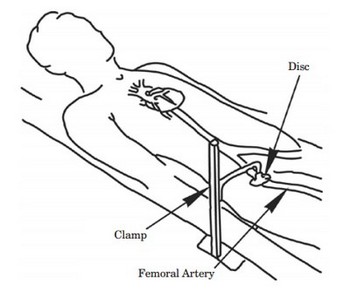What should I expect?
Before the angiogram
- Before your angiogram procedure starts, your doctor and nurses will review your medical history, medications and any allergies you may have
- You will change into a hospital gown and an intravenous (IV) line will be placed in your arm. An electrocardiogram (ECG), your vital signs and blood pressure will be done. The team may also perform a physical exam. The doctor will decide based on your exam whether the angiogram access site will be at the wrist or groin.
- You may have to remove contact lenses, eye glasses, jewelry and hairpins. You will be asked to empty your bladder before the procedure.
During the angiogram
- Once in the angiogram suite, you will move onto the procedural table. Electrodes will be placed on your chest to monitor your heart rhythm. A cuff will be attached to your arm to track your blood pressure. A special probe called a pulse oximeter will be placed on your finger to monitor the amount of oxygen in your blood.
- The nurse will prepare the access site, most commonly the right groin or wrist. This may require a small amount of hair to be shaved. The site will then be cleaned with a cold cleaning solution. It is important that you do not touch this area once it is cleaned.
- You will be awake during the procedure and will be asked to follow simple instructions. You may be given medicine through the IV to help you relax, as well as other medications and fluids.
- The nurse will place a sterile (germ-free) drape over your body to keep the procedure site clean.
- The cardiologist will inject local anesthetics (freezing – like at the dentist) into the groin or wrist area. Once the area is ‘numbed’ a small puncture is made at the entry site and a short plastic tube called a sheath is inserted into your artery.
- Various catheters (long thin tubes) will be used to visualize the arteries in your heart and how your valves function. Threading the catheter should not cause pain, and you will not feel it moving through your body. Tell your doctor or the staff in the lab if you have any discomfort.
- Through the catheters, the cardiologist will inject small amounts of X-ray contrast (‘dye’) to see the coronary arteries. There is an injection of dye to watch the pumping chamber of the heart (the left ventricle) and it is normal to feel a warm sensation over your body at this time. The X-ray camera will move over and around your body to take pictures from many different angles.
- Throughout the procedure you may be asked to take deep breaths, hold your breath, cough or place your arms in various positions. Once we have enough pictures of your heart, the cardiologist will remove the catheter. Sometimes the sheath is removed in the lab with a special closure device or small plug and other times the sheath may be removed upon your return to the recovery area.
- Your doctor may talk to you about the findings part way through the angiogram and perform additional procedures if necessary. Additional procedures may include angioplasty with stent placement to open up a narrowed artery.
After the angiogram
- When the angiogram is over, the catheter is removed from your wrist or groin area and there will be manual compression on the incision site. You will be taken to a recovery area for observation and monitoring.
- Nurses will check your heart rhythm, blood pressure, wrist or groin, and feet or arm pulses frequently.
- You are encouraged to drink plenty of clear fluids to help clear the X-ray contrast (‘dye’) from your kidneys. The nurses will tell you when it is safe to eat. Eating too soon may cause complications.
- An angiogram is not a painful procedure. Please tell the nurse if you have significant chest pain or discomfort following the procedure.
- The team will give you clear instructions about how to take care of the access site following the procedure and before you are discharged home.
Femoral Artery Access
- You should not bend your knees, lift your head off the pillow or move out of bed by yourself. Any of the above may cause bleeding and damage to your artery. The nurse or doctor will remove the sheath from your groin when it is safe to do so. This may be a few minutes to a few hours after the procedure.
- After removing the sheath the nurse will put a clamp on to compress the artery. At the beginning, the pressure applied may be quite strong. Typically, the pressure will be slowly released over the next hour.
- One hour after the clamp is removed, you will be allowed to sit up and eat.
- Three hours later you will be allowed to walk on your own. You may be discharged home approximately 4 hours after the procedure.

Radial Artery Access
- After removing the sheath the nurse will put an air filled wrist band on to compress the artery. At the beginning, the pressure applied may be quite strong. The pressure will be slowly released over the next one to two hours.
- After the wrist band is removed it is important not bend your wrist for 6 hour and to not use your wrist for the next 24 hours.
Next article:


